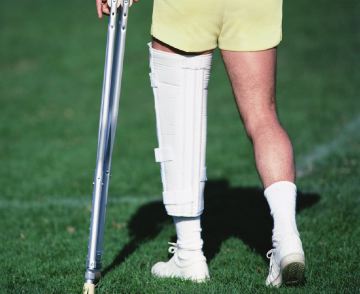
NCAA's disability coverage insures student-athletes who have
pro potential and provides coverage for 360,000 others
By Samuel Schiff

In John Grisham's recent book, Bleachers, the main character is an All-American high school football star and town hero whose college and possible lucrative professional career are cut short by a crippling injury. While Grisham's character, Neely Crenshaw, is fictional, the scenario is not. Promising pro sports careers can be abruptly ended by catastrophic injury--and no organization is more aware of the problem than the National Collegiate Athletic Association (NCAA).
Addressing the problems associated with a career-ending injury, the NCAA offers two insurance programs designed to protect the student-athlete in the event of crippling injury. "The first," says Juanita L. Sheely, NCAA travel and insurance coordinator, "is the Exceptional Student-Athlete Disability Insurance (ESDI) Program, which was started in 1990. The second, the Catastrophic Injury Insurance Program, has been in place in its current form since the early 1990s. It began as a subscription program in the late 1980s, and each school paid its own premium."
The ESDI program was initiated in October 1990 for exceptional football and basketball student-athletes at NCAA institutions. Shortly thereafter, in April 1991, the program was expanded to include exceptional athletes in baseball, and in June 1993 it was further expanded to include men's ice hockey. The most recent expansion of the ESDI program occurred in August 1998 when women's basketball was added. "The growing popularity of the sport and the development of the professional leagues was a primary reason for its inclusion," Sheely says.
Eligibility in the ESDI program is limited to those athletes who have demonstrated they have professional potential and are projected to be selected in the first three rounds of the National Football League or National Hockey League draft or the first round of the National Basketball Association, Women's National Basketball Association or Major League Baseball draft. Currently there are about 100 athletes in the program, and the number varies from year to year, Sheely explains.
A student-athlete's professional potential is determined by the ESDI program administrator, ASU International. "As program administrator, we determine the amount of coverage available for each participant in the ESDI based upon his or her prospective status in the upcoming draft for the particular sport," says Michael Thompson, special risk underwriter for ASU. "The rates per thousands of dollars of coverage will be based on market value at the time the individual applications are reviewed."
ASU International, LLC, specializes in the development and management of sports-related disability programs. It is a wholly owned subsidiary of HCC Insurance Holdings, an international insurance holding company with operations in Bermuda, Spain and the United Kingdom as well as offices across the United States. The carrier has achieved an outstanding record of growth and profitability since its inception in 1974.

In addition to the NCAA, its list of major clients includes Reebok, Blockbuster, Coca-Cola, Spalding, Major League Baseball, and the National Football League. Also on its roster are the National Hockey League, the New York Yankees and the Cleveland Indians, the Tostitos Fiesta Bowl, Foxwoods, Anheuser-Busch, Kawasaki, Visa and Yahoo.
"Once the review process is complete," Thompson explains, "applicants will receive notification of the amount of coverage offered with a statement of prevailing rates for sport and position." The maximum coverages available under the ESDI program are: men's basketball, $4.4 million; football, $3.0 million; baseball, $1.5 million; men's ice hockey, $1.2 million; and $250,000 for women's basketball. Insuring the program is the Hartford Life Insurance Company. As such it is responsible for the investigation and settlement of all claims associated with the program.
Protecting future earnings
Participation in the program enables qualifying student-athletes, as approved by the program administrator, to purchase disability insurance contracts with preapproved financing, if necessary. It thus gives the participant the opportunity to protect against future loss of earnings as a professional athlete, due to a disabling injury or sickness that may take place during his or her collegiate career. ESDI offers a permanent total disability (PTD) policy. A 24-month maximum policy term is available for any underclassman/woman eligible for the program. The policy provides 24-hour accident and sickness coverage, which includes playing and practicing in the student-athlete's respective sport.
Six criteria must be met under the definition of disability:
* The disability results from an injury or sickness
* The injury or sickness takes place while the policy is in force
* The student-athlete is under the regular care of a qualified physician
* The student-athlete is unable to engage in sporting activity at the professional level
* The applicable elimination period has elapsed
* The total disability prevents him or her from signing any employment contract with any professional team as a professional athlete in his or her chosen activity.
"The ESDI program is designed to help those students who have the potential to play professionally protect their future earnings," Sheely says. "So it is unlikely that it will expand to cover all student-athletes. However, we frequently review the program to make sure we are covering the proper rounds of the draft and that our program limits are in line with professional salaries. Thus some changes to the program are possible in the future."
While the student-athlete with professional potential is covered under the ESDI program, what about the 360,000 student-athletes who participate in intercollegiate sports and will never make it to the pros? "For these student-athletes at active member institutions, they are automatically covered under the Catastrophic Injury Insurance Program," says Sheely. "This program provides coverage for the student-athlete who is catastrophically injured while participating in a covered intercollegiate athlete activity. This includes all NCAA-regulated sports." The policy has a $65,000 deductible and provides benefits in excess of any other valid and collectible insurance.
"All active member schools in the NCAA are covered," Sheely points out. "That currently stands at 326 Division I schools, 279 in Division II and 423 in Division III. The total of 1,028 is augmented by a number of other memberships, bringing the total to 1,290 schools."
A catastrophic injury, according to Sheely, "would be one that leaves the student-athlete partially or totally disabled. However, for the purposes of our catastrophic program, a student-athlete would be eligible for at least some of the benefits of the policy, assuming all conditions were met, by just having medical bills that exceed the $65,000 program deductible."
"Claims are submitted to our program administrator, ASU, which subsequently informs the underwriter, Mutual of Omaha," Sheely says. "In the next step a nurse case manager is assigned to the claim by Mutual of Omaha. The case manager will work with the family, school and any other stakeholder to ensure the student-athlete is receiving everything he or she needs."
Flexible program
There is also a degree of flexibility in the catastrophic injury program depending on the particular situation, as the following example shows. The NCAA and Mutual of Omaha agreed to modify the benefits available to a collegiate football player to allow him to resume his playing career. The policy changes will enable him to maintain existing NCAA coverage while also playing football. The player had sustained a football injury that resulted in the amputation of his right leg. Previously, under the terms of the catastrophic injury policy, he would not have been allowed to play football and also receive benefits because the policy does not provide coverage for a prior injury if an individual is deemed healthy to compete.
"We are very pleased that we were able to come to a resolution that would offer him an opportunity to receive the care he needs and to continue to play football," said (then) NCAA President Ced Dempsey. "This is an extraordinary situation with a unique set of circumstances. He is an extremely courageous individual, and we wish him the best."
The terrorism on September 11, 2001, has also had an impact on the NCAA, and the management of collegiate sports risk has grown more complicated in recent times. Recognizing the need to plan for years to come, the NCAA Executive Committee appointed a risk management and insurance task force in April 2003 to assess the organization's current situation. The task force has examined two separate issues: traditional insurance questions, especially those involving athletically related injuries, and safeguarding the Association's overall business interests through an effective risk management program.
An effective program is vital. "For fiscal year 2002-03 our annual insurance bill will be about $13 million," says Keith Martin, NCAA managing director of finance and business operations. "More than $9.2 million of that total will go toward the catastrophic injury insurance program, which provides up to $20 million in lifetime benefits to varsity student-athletes who are catastrophically injured during qualifying play or practice, or during travel related to those activities." Like most other insurance premiums, the cost of the NCAA insurance programs has increased significantly, with the annual premium more than doubling since 1997. The NCAA Executive Committee received the recommendations of the task force in November, and they have been forwarded to each division for its comments.
The Association's two insurance programs appear to cover virtually all the problems that can arise from thousands of students at hundreds of colleges participating in scores of athletic programs. If only Grisham's hero, Crenshaw, had been covered through the NCAA, his career-ending injury wouldn't have been so painful. *